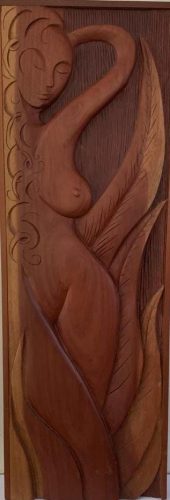By Akima McPherson
Thus far in this series, I have discussed the question of what is art, two (2) elements of art, and some principles of design. Fundamental to all this, however, must be an understanding of the three (3) basic ingredients of art. For a thing, object, or gesture to gain the status of art it must possess a subject, content, and form. While these words are common, they refer to very specific things in art that are not immediately recognised. In fact, it is often the case that the words ‘subject’ and ‘content’ are used interchangeably, while form is used to mean type. The subject of a work of art is the person, object, or theme about which the work is made. Content refers to the message or ideas the artist is conveying about the person, object, or theme. Form, on the other hand, refers to the work’s total appearance.

Not only are the lines which compose the body in Sensual Form beautiful, but so too is the way in which the body hugs the right edge of the composition and is obscured by a cascade of curly locks or is excluded altogether. The result is that the right side of her body is hidden behind a curtain of hair or absence while the left side is clearly visible and sensualised. The lack of detail to the right of the woman’s body helps to keep our eye returning to the aforementioned line which defines a curvy body in a sensual pose. Balancing the composition, Garnett-Williams carves large leaves which she defines using lines on the left side of the composition. Meanwhile, in the background of the composition – in the space not occupied by the female nude or the large leaves – Garnett-Williams has carved long vertical lines, which are closely spaced. The result is a sense of shallow depth is communicated and the body is further made the subject of the sculpture. There is much to be said about the form in Garnett-Williams’ relief carving.
In addition to lines, we may want to discuss the shapes evident in a work. We may speak of (as with line) actual shape – the shape has exact limits, or implied shapes which are suggested by connecting broken lines, dots, etc. to suggest the presence of a shape not physically present.
Additionally, we may be able to speak of biomorphic shapes. These are irregular shapes, rounded so they are simultaneously organic and abstract. Of course, we may speak of geometric shapes – shapes that are mathematical, mechanical, and rigid (triangles, rectangles, etc.). and organic shapes which are often curvilinear and similar to those found in nature, such as plants and animals. In Sensual Form, we see an abundance of organic shapes.
Similar to discussing the presence of lines and shapes in a work, we can discuss the actual and/or implied texture in a work. Actual texture is the texture that can be felt in the work if you were allowed to touch the work. Implied texture is suggested but is not actually felt if you were to touch the work. Abstract texture simplifies the actual texture while invented texture is wholly invented and does not relate to the real-life texture of the object or thing.
Some points to note about line, shape and texture are that they:
1. have different visual weights depending on how they are used,
2. have a directional quality and can move the eye around a picture,
3. can give emphasis, and
4. can communicate emotion singularly or in relation to each other.
What we have been discussing in the last four (4) paragraphs is the form of the work; how it presents itself. Furthermore, in exploring form, we can discuss the type of work – whether the work is a painting or sculpture or installation. If the work is sculpture as in the case of Sensual Form, we can speak of the work being a low-relief, being made of wood (even a particular type of wood), the techniques used, and of course how the elements of art and the principles of design are used. Focusing on the form of the work, allows one to engage in a formal analysis of the work and therefore critique (not criticize) the work using the methods of formalist critics of art.
At this point in the series, I invite you to visit the National Gallery of Art (NGA) Castellani House on Homestretch and Vlissengen Road. It is a public place and free to visit. Works from Guyana’s National Collection are currently on view there. Perhaps your visit will also coincide with a temporary exhibition of artists’ work, not in the National collection. An additional treat, if that is the case. Take a walk around. See if the points I have raised in these first articles have helped you in your appreciation of the work on display. I hope some do. As you leave, you may wish to visit the 1763 Monument, south of the NGA’s compound. In article six I will discuss scale and proportion, and repetition and rhythm using this iconic work as the subject.
Akima McPherson is a multi-media artist, art historian, and educator.






